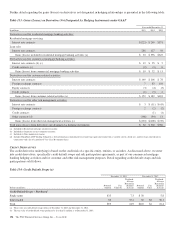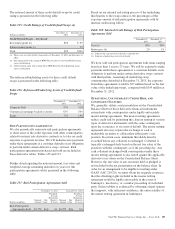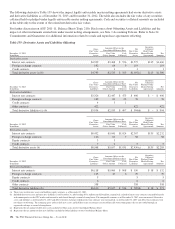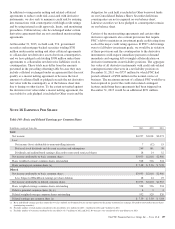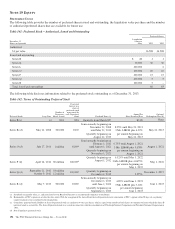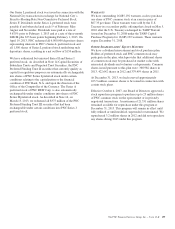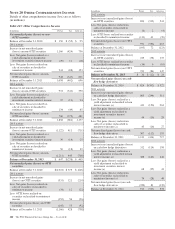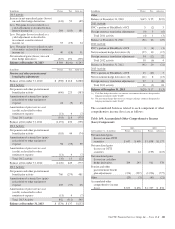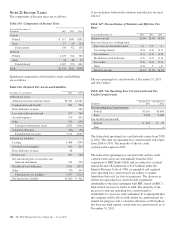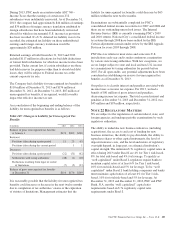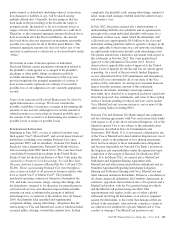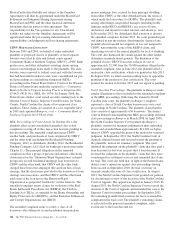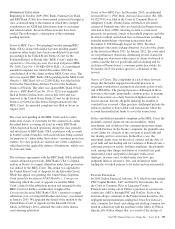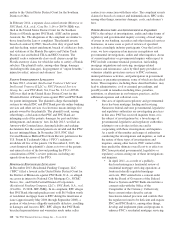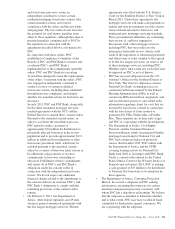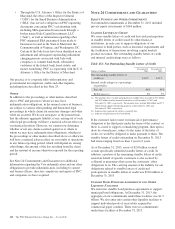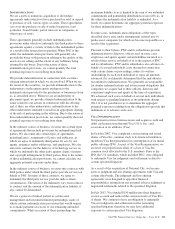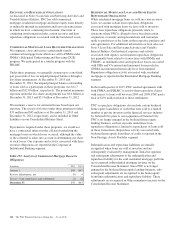PNC Bank 2013 Annual Report Download - page 222
Download and view the complete annual report
Please find page 222 of the 2013 PNC Bank annual report below. You can navigate through the pages in the report by either clicking on the pages listed below, or by using the keyword search tool below to find specific information within the annual report.
The following table sets forth the Basel I regulatory capital
ratios for PNC and its bank subsidiary, PNC Bank, N.A.
Table 150: Basel I Regulatory Capital
Amount Ratios
December 31
Dollars in millions 2013 2012 2013 2012
Risk-based capital
Tier 1
PNC $33,612 $30,226 12.4% 11.6%
PNC Bank, N.A. 28,731 28,352 11.0 11.3
Total
PNC 42,950 38,234 15.8 14.7
PNC Bank, N.A. 37,575 35,756 14.3 14.2
Leverage
PNC 33,612 30,226 11.1 10.4
PNC Bank, N.A. 28,731 28,352 9.8 10.1
The principal source of parent company cash flow is the
dividends it receives from its subsidiary bank, which may be
impacted by the following:
• Capital needs,
• Laws and regulations,
• Corporate policies,
• Contractual restrictions, and
• Other factors.
Also, there are statutory and regulatory limitations on the
ability of national banks to pay dividends or make other
capital distributions. The amount available for dividend
payments to the parent company by PNC Bank, N.A. without
prior regulatory approval was approximately $1.4 billion at
December 31, 2013.
Under federal law, a bank subsidiary generally may not extend
credit to, or engage in other types of covered transactions
(including the purchase of assets) with, the parent company or
its non-bank subsidiaries on terms and under circumstances
that are not substantially the same as comparable transactions
with nonaffiliates. A bank subsidiary may not extend credit to,
or engage in a covered transaction with, the parent company
or a non-bank subsidiary if the aggregate amount of the bank’s
extensions of credit and other covered transactions with the
parent company or non-bank subsidiary exceeds 10% of the
capital stock and surplus of such bank subsidiary or the
aggregate amount of the bank’s extensions of credit and other
covered transactions with the parent company and all non-
bank subsidiaries exceeds 20% of the capital and surplus of
such bank subsidiary. Such extensions of credit, with limited
exceptions, must be at least fully collateralized in accordance
with specified collateralization thresholds, with the thresholds
varying based on the type of assets serving as collateral. In
certain circumstances, federal regulatory authorities may
impose more restrictive limitations.
Federal Reserve Board regulations require depository
institutions to maintain cash reserves with a Federal Reserve
Bank (FRB). At December 31, 2013, the balance outstanding
at the FRB was $11.7 billion.
N
OTE
23 L
EGAL
P
ROCEEDINGS
We establish accruals for legal proceedings, including
litigation and regulatory and governmental investigations and
inquiries, when information related to the loss contingencies
represented by those matters indicates both that a loss is
probable and that the amount of loss can be reasonably
estimated. Any such accruals are adjusted thereafter as
appropriate to reflect changed circumstances. When we are
able to do so, we also determine estimates of possible losses
or ranges of possible losses, whether in excess of any related
accrued liability or where there is no accrued liability, for
disclosed legal proceedings (“Disclosed Matters,” which are
those matters disclosed in this Note 23). For Disclosed
Matters where we are able to estimate such possible losses or
ranges of possible losses, as of December 31, 2013, we
estimate that it is reasonably possible that we could incur
losses in an aggregate amount of up to approximately $800
million. The estimates included in this amount are based on
our analysis of currently available information and are subject
to significant judgment and a variety of assumptions and
uncertainties. As new information is obtained we may change
our estimates. Due to the inherent subjectivity of the
assessments and unpredictability of outcomes of legal
proceedings, any amounts accrued or included in this
aggregate amount may not represent the ultimate loss to us
from the legal proceedings in question. Thus, our exposure
and ultimate losses may be higher, and possibly significantly
so, than the amounts accrued or this aggregate amount.
The aggregate estimated amount provided above does not
include an estimate for every Disclosed Matter, as we are
unable, at this time, to estimate the losses that it is reasonably
possible that we could incur or ranges of such losses with
respect to some of the matters disclosed for one or more of the
following reasons. In our experience, legal proceedings are
inherently unpredictable. In many legal proceedings, various
factors exacerbate this inherent unpredictability, including,
among others, one or more of the following: the proceeding is
in its early stages; the damages sought are unspecified,
unsupported or uncertain; it is unclear whether a case brought
as a class action will be allowed to proceed on that basis or, if
permitted to proceed as a class action, how the class will be
defined; the other party is seeking relief other than or in
addition to compensatory damages (including, in the case of
regulatory and governmental investigations and inquiries, the
possibility of fines and penalties); the matter presents
meaningful legal uncertainties, including novel issues of law;
we have not engaged in meaningful settlement discussions;
discovery has not started or is not complete; there are
significant facts in dispute; and there are a large number of
204 The PNC Financial Services Group, Inc. – Form 10-K


